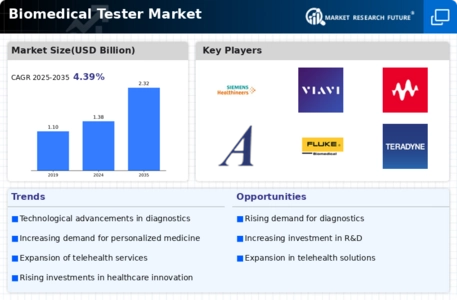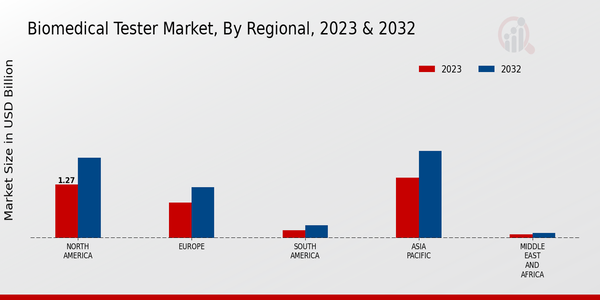Market Growth Projections
The Global Biomedical Tester Market Industry is poised for substantial growth, with projections indicating a market value of 1.38 USD Billion in 2024 and an expected increase to 2.32 USD Billion by 2035. This growth trajectory suggests a compound annual growth rate (CAGR) of 4.84% from 2025 to 2035. Such figures highlight the increasing importance of biomedical testing in healthcare, driven by factors such as technological advancements, rising chronic disease prevalence, and government support. The market's expansion reflects a broader trend towards improved diagnostic capabilities and patient care globally.
Technological Advancements
The Global Biomedical Tester Market Industry is experiencing rapid technological advancements that enhance testing accuracy and efficiency. Innovations in biosensors, microfluidics, and automation are driving the development of sophisticated biomedical testing devices. For instance, the integration of artificial intelligence in diagnostic tools is improving predictive analytics, which may lead to better patient outcomes. As a result, the market is projected to reach 1.38 USD Billion in 2024, reflecting the growing demand for advanced testing solutions. These advancements not only streamline testing processes but also reduce operational costs, making them attractive to healthcare providers globally.
Government Initiatives and Funding
Government initiatives and funding play a crucial role in the expansion of the Global Biomedical Tester Market Industry. Various governments are investing in healthcare infrastructure and research to improve diagnostic capabilities. For example, funding for biomedical research and development has increased, leading to the creation of innovative testing solutions. These initiatives often focus on enhancing public health outcomes and reducing healthcare costs. As a result, the market is likely to benefit from increased public and private partnerships aimed at advancing biomedical testing technologies. This supportive environment is expected to foster growth and innovation within the industry.
Emerging Markets and Global Expansion
Emerging markets are becoming increasingly important in the Global Biomedical Tester Market Industry, as they present new opportunities for growth. Countries in Asia-Pacific, Latin America, and Africa are experiencing rapid economic development, leading to increased healthcare spending. This trend is encouraging investments in biomedical testing technologies to meet the rising demand for healthcare services. As these markets expand, they are likely to adopt advanced testing solutions, further driving the growth of the industry. The potential for market penetration in these regions is substantial, as healthcare providers seek to enhance diagnostic capabilities and improve patient care.
Rising Prevalence of Chronic Diseases
The increasing prevalence of chronic diseases globally is a major driver for the Global Biomedical Tester Market Industry. Conditions such as diabetes, cardiovascular diseases, and cancer necessitate regular monitoring and testing, thereby boosting the demand for biomedical testing devices. According to health statistics, chronic diseases account for a significant portion of global healthcare expenditures, prompting healthcare systems to invest in effective diagnostic tools. This trend is expected to contribute to the market's growth, with projections indicating an increase to 2.32 USD Billion by 2035. The need for early detection and management of these diseases underscores the importance of biomedical testing.
Growing Demand for Point-of-Care Testing
The demand for point-of-care testing (POCT) is surging within the Global Biomedical Tester Market Industry, driven by the need for rapid and accurate diagnostic results. POCT allows for immediate testing and results at the site of patient care, which is particularly beneficial in emergency situations. This trend is supported by the increasing focus on patient-centered care and the desire to reduce hospital visits. The market for POCT is projected to grow significantly, contributing to the overall market growth, with a compound annual growth rate (CAGR) of 4.84% anticipated from 2025 to 2035. This shift towards decentralized testing is reshaping the landscape of biomedical diagnostics.












